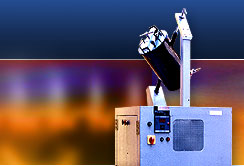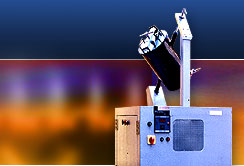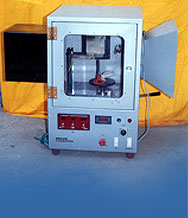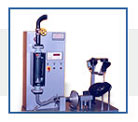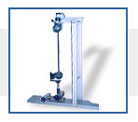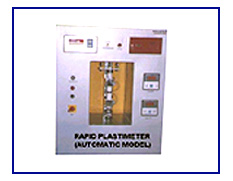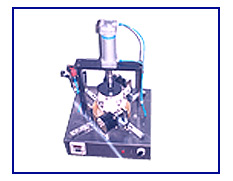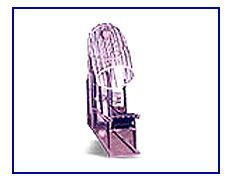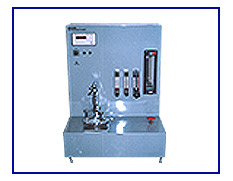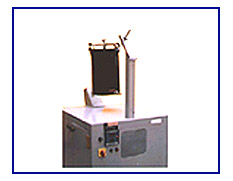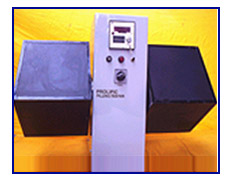We at,
Prolific Engineers, are
manufacturers, exporters and suppliers of adhesion testers, adhesive testing
equipment, automobile accessories testing equipment, building hardware
testing equipment, cables & conduits testing equipment in India.
Rapid Plastimeter
A rapid plastimeter is commonly used for
simple and quick determination of plasticity of unvulcanized and raw
rubbers. It is very simple in operation and does not need any special skill
or judgement for obtaining reliable values of plasticity. This equipment can
also be used for testing polyurethane.
The PROLIFIC Rapid Plastimeter consists of a pair of parallel circular
platens of smooth flat surface movable in relation with one another. Both
the platens are heated with the help of individual electric heaters so that
the material being tested and the area surrounding it can be maintained at
test temperature of 100 oC. The temperature is controlled with the help of
individual temperature indicator cum controllers.
Both the platens are made of chrome plated bronze with lower platens having
provisions of holding stainless steel anvils. Three anvils are provided to
cover a wide range of plasticity.
In the Manual Model, a manually operated lever rapidly moves down the upper
platen for compressing the specimen to an initial thickness of 1.00 mm
through a cam operated loading arrangement. A dead weight and lever
arrangement applies the test load on the specimen through the lower platen.
A dial gauge indicator is provided to continuously monitor the thickness of
the test specimen.
In the Automatic Model, a pneumatic cylinder rapidly moves down the upper
platen for compressing the specimen to an initial thickness of 1.00 mm. The
specified test load is then applied on the specimen automatically through
the lower platen after the specified duration with the help of a dead weight
and another pneumatic cylinder. The thickness of the specimen during the
test is indicated on a digital thickness meter with the help of a LVDT. The
reading of the display of thickness is frozen at the end of the test
duration. The timing for pre-heating and test duration are indicated and
controlled with the help of a double display electronic timer. The whole
testing is totally automatic. The compressed air line with air pressure of 7
kg / cm2 or higher is to be provided by the user. A motor operated
compressor with pressure switch is available as optional accessory.
An arrangement for compensating for the thickness of tissue paper is
provided, which is carried out only when there is any change in the
thickness of tissue paper used.
The various components are fixed on a steel fabricated panel with various
digital indicators fitted in front of the same. The panel is finished in
grey enamel paint. Various components are bright chrome / zinc plated to
give them a corrosion resistant finish.
A punch for preparing test specimen of required size is available as an
optional accessory.
|
TECHNICAL DATA |
|
Dimensions of upper anvils |
7.3 mm, 10.0 mm, and 14.0 mm dia - 4.5 mm
thickness |
|
Test temperature |
100º C |
|
Test load |
10.2 kg |
|
RELEVANT STANDARD |
|
IS 3660 (Part 11) - 1989 |
Methods of Test for Natural Rubber
Part 11 : Determination of Plasticity |
|
BS:903 : Part A59 -1990 |
Physical Testing of Rubber
Part A59 - Method using Plastimeter |
|
ASTM D3194 - 99 |
Standard Test Method for Rubber from National
Sources Plasticity Retention Index (PRD) |
The ability of conveyor belts to
withstand successfully without igniting the effects of heat produced in it
due to friction encountered by it while running is ascertained by subjecting
a test specimen cut out of the belt to a drum friction test.
In this test, the test specimen is bent over a steel drum into a
semi-circular shape under a specified tension and is held in such a way that
it cannot move. The drum is rotated at a fixed speed against the belt, thus
producing heat because of frictional force between the belt and the drum. An
air current is provided to cool the drum during the running operation.
The PROLIFIC Drum Friction Tester for conveyor belts consists of a rigid
fabricated frame made from mild steel channels and angles. A steel drum of
200 mm diameter and 350 mm length is mounted on a set of ball bearings and
serves as the friction drum for the test. The top surface of the drum is
hard chrome plated to providing abrasion resistance.
Motion to the drum is given with the help of a counter-wheel and a chain
and sprocket arrangement. The drive to the counter-wheel assembly is given
from a 3 phase - 10 HP (7.5 kW) motor through a belt and pulley arrangement.
The speed of rotation of friction drum is 190 ± 10 rpm. A suitable
starter for safety of the motor is also provided.
The test specimen is held in a flat grip at one end and bends through an
angle of 180° over the friction pulley. It then passes over a guide
pulley of 70 mm diameter and 250 mm length. The free end of the belt hangs
vertically below the guide pulley. A dead weight of 32 kg can be suspended
from this free end to apply the required tension on the test specimen. A
micro-switch is provided to stop the motor on breakage of the test specimen.
A digital temperature indicator with a thermocouple probe is provided for
measuring the temperature of the drum surface.
An air line of 12.5 mm diameter having holes on one side is fixed at a
specified distance from the drum to provide cooling to it. A rotating vane
type anemometer with analogue output is provided to measure the airflow. A
filter regulator with pressure gauge is provided to supply air at regulated
pressure to the air line.
Air compressor with an electric motor and pressure switch is available as
optional accessory with the equipment.
|
RELEVANT SPECIFICATIONS |
|
IS 3181 - 1978 |
Specification for Fire Resistant Conveyor Belting
for Underground Use in Coal Mines |
|
IS 1891 (Part 5) - 1993 |
Conveyor and Elevation Textile Belting -
Specification
Part 5 : Fire Resistance Belting for Surface Application |
|
Department of Energy, Mines and Resources
Canada |
Certification of Fire Resistant Conveyor Belting
for use in Mines (Second Edition - March 1969) |
When any game is conducted on a wet
field or under rain, the surface of the ball used for the game undergoes
some changes. One of these changes is in its weight while the other change
is in its circumference. Also, repeated usage of a ball under wet conditions
may also reduce its useful life.
The effect of moisture on these three parameters is checked by subjecting a
football inflated to a pressure of one bar and placed it in a shallow water
trough containing a two centimetre high column of water to a simulated test.
In this test the ball is rotated within the trough to enable it to get wet
symmetrically over whole of its surface. The ball is simultaneously pressed
down into the water trough. The increase in its weight and circumference are
checked after a specified number of pressing operations to evaluate the
effect of soaking wet conditions after a full game.
The PROLIFIC Water Uptake Tester for footballs consists of a water trough
in which the ball is kept for wetting, a pneumatically operated arrangement
to press down the ball repeatedly after a pre-set time interval, two
adjustable rotating cylindrical nylon discs for supporting the ball on two
side at right angles to each other, and two synchro-set motors positioned at
right angle to each other to rotate the ball when it is not being pressed,
alternately in clockwise and anti-clockwise directions.
The water trough is made of brass casting. Water is kept inside the trough
to a height of two centimetres. The ball is placed in the centre of the
trough and is in contact with its base. It is held in position with the help
of two adjustable rotating cylindrical nylon discs.
The pressing arrangement for the ball consists of a pneumatic cylinder, a
timer, a solenoid valve, and a FRL unit. The force exerted by the pressing
plate on the ball can be altered by adjusting the pneumatic pressure.
The ball is rotated when it is not being pressed with the help of two
synchro-set motors. These motors are positioned at right angle to each
other. Only one motor is operated at one time. The two motors are operated
alternately with the help of the same timer, which also controls the
movement of the pneumatic cylinder, thus synchronizing the three movements.
A digital counter with memory backup for counting the number of pressings
and stopping the test after a pre-set number of operations is also provided.
The equipment is finished in grey hammertone stoving painting and bright
chrome / zinc plating to give it a corrosion resistant finish. Parts that
are in contact with water are made from non-corrosive materials.
|
TECHNICAL DATA |
|
Maximum diameter of balls which can be tested
|
250 mm |
|
Force exerted on the balls |
Adjustable |
|
Frequency of pressing operations |
40 cycles per minute |
|
Counter |
4 digit pre-set type digital counter with memory
backup |
The effect of normal use on the surface
of a football is determined by subjecting the ball to a simulated test where
it is shot against a flat surface repeatedly and the effect of such impacts
on its surface observed to evaluate its quality.
One of the methods employed for this simulation uses two cylindrical
rollers to compress the ball. The ball, on coming out of the rollers, shoots
forward at a high speed and strikes the test surface placed at a fixed
distance. It is then guided back to the rollers and the action gets repeated
automatically. The effect of these impacts on the surface is observed At the
end of desired number of impacts to ascertain its quality.
The PROLIFIC Shooter Tester for footballs (roller type) consists of two
rollers between which the ball is compressed, a steel plate placed at a
known distance from the rollers against which the ball strikes, and a
guiding arrangement to bring the ball back to the rollers.
The rollers are made of mild steel plates and have a lining of plastic
sheet fixed to them to act as a friction surface. The distance between the
rollers can be adjusted to enable balls of different diameters to be pinched
between the rollers and get compressed, as also to give the desired
percentage compression to the ball.
One of the rollers is fixed while the other can be moved towards or away
from it to change the distance between them. Both the rollers are given a
positive drive with the help of a chain. The direction of movement of the
rollers is opposite to each other. A chain tensioning arrangement is
provided to compensate for the change in length of the chains due to the
lateral movement of the rollers.
The steel surface against which the ball strikes after coming out of the
rollers is placed at a fixed distance from the rollers. The lining on the
test surface may be changed if it is desired to study the effect of impact
against any specified surface such as concrete, asto-turf, wood, etc. Its
inclination can be changed to adjust the trajectory of the ball after impact
so that it can be caught in the guiding arrangement which takes it back to
the rollers.
The ball is routed back to the rollers inside a cage made from steel rods.
If the ball fails to be entrapped in the guide it can be placed back in the
guide manually without stopping the rotation of the rollers.
The number of impacts given to the ball is counted with the help of a
digital counter having a backup memory to retain the count on failure of
electric supply. The counter is operated by an optical sensor which counts
the number of times the ball passes between the rollers.
The equipment is finished in gray hammertone painting and bright chrome /
zinc plating to give it a corrosion resistant finish.
|
TECHNICAL DATA |
|
Diameter of rollers |
60 ± 1 cm |
|
Width of rollers |
30 cm |
|
Distance between rollers |
14 - 22 cm (adjustable) |
|
Speed of rotation of rollers |
380 ± 10 rpm |
|
Distance of impact surface from the centre of
rollers |
250 ± 20 cm |
|
Inclination of impact surface |
8 to 30° to vertical (adjustable) |
|
Motor |
2 HP - three-phase 400 volts AC |
|
Counter |
Four digit pre-set counter with memory back up
|
|
RELATED STANDARDS |
|
ASTM D 1894 - 1967 |
Standard Test Methods for Static and Dynamic
Coefficients of Friction of Plastic Films and Sheetings |
|
ISO 8295 - 1995 |
Plastics - Film and Sheeting - Determination of
the Coefficients of Friction |
Air permeability is the property of a
fabric to allow passage of air through it under the effect of a difference
in pressure across its two faces. It is defined as the volume of air passing
through a defined area under a specified pressure difference over a known
period of time. It is a very important property for fabrics which are used
under conditions where it is necessary to know precisely the amount of air
passing through it.
The PROLIFIC Air Permeability Tester for textiles consists of an
arrangement to hold the test specimen between two flat faces so as to expose
a known area to the flow of air through it, a vacuum system to draw air
through the exposed area of the test specimen, arrangement to measure the
volume of air flowing through the test specimen, and arrangement to measure
the pressure drop between the two faces of the test specimen as a result of
flow of air.
The test specimen is held between two annular ring shaped grips. The grips
are lined with rubber gaskets to reduce flow of air through the edges. The
two grips can be brought in contact with each other with the help of a hand
operated screw arrangement. The test area can be altered by placing adapter
discs of different openings in the grips.
The vacuum needed to draw air through the exposed area of the test specimen
is created with the help of a vacuum pump supplied with the equipment. The
volume of air passing through the test area is measured with the help of a
set of rotameters. A digital pressure indicator is provided to indicate the
difference in pressure between the two faces of the test specimen.
The equipment is assembled over a sheet metal panel and is finished in grey
hammertone stoving painting and bright chrome / zinc plating to give it a
corrosion resistant finish.
|
TECHNICAL DATA |
|
Test area |
10, 20, 50, and 100 cm² |
|
Rotameters |
9 to 90; 65 to 650; 360 to 3,600; and 1,940 to
19,400 lph at NTP (accuracy ± 3% of FSR in each range) |
|
Pressure indicator |
Electronic type with a pressure transducer and
digital display to measure and indicate pressure upto 999 mm water
column (least count 1 mm) |
|
RELATED STANDARD |
|
IS 11056 - 1984 |
Method for Determination of Air Permeability of
Fabrics |
|
DIN 53887 |
Testing of Textiles - Determination of the Air
Permeability of Fabrics |
Dry cleaning apparatus is used for
preparing fabric samples for flammability testing. This apparatus can also
be used for testing color fastness and dimensional changes during dry
cleaning and during laundering.
The PROLIFIC Dry Cleaning Apparatus consists of a motor driven corrosion
resistant stainless steel tumbler, which rotates around an axis 50° inclined to tumbler axis at approximately 45 rpm. The tumbler is also
provided with a stainless steel cover with a rubber seal and a quick acting
positive clamp. The tumbler is rotated with the help of an electric motor
through pulley-belt, reduction gearbox, and chain and sprocket drive.
A pre-set type digital timer of 999 minutes is provided to indicate the
actual run time and also to stop the motor after a pre-set time interval.
The equipment is built on a sturdy fabricated table type structure with
lockable storage space for keeping the samples.
The apparatus is finished in grey hammertone / black enamel stoving
painting and bright chrome / zinc plating to give it a corrosion resistant
finish.
|
TECHNICAL DATA |
|
Dimensions of tumbler |
220 mm diameter x 330 mm high |
|
Rotational speed of tumbler |
45 rpm |
|
Axis of rotation |
Inclined at an angle of 50° to the tumbler
axis |
|
Timer |
Pre-set digital timer 999 minutes x 1 minute |
|
Motor |
¼ HP single-phase 230 volts AC |
|
RELATED STANDARD |
|
Code of Federal Regulation (USA) Title 16,
Chapter II, Part 1610 - Standard for the Flammability of Textile
Clothing. |
Pilling is a fabric surface fault
characterized by little pills of entangled fibres clinging to the surface.
These are formed during wearing or washing by the entanglement of the loose
fibres, which protrude from the fabric surface, and development of these
into spherical bundles anchored to the fabric by a few unbroken fibres.
These give a very unsightly look to the garments.
To determine the tendency to form pills, test specimens taken from the
fabric sample are rubbed against each other under controlled conditions and
the appearance of the test specimen after rubbing for the specified period
is compared against standard rating photographs for grading the fabric under
test.
The PROLIFIC Pilling Tester consists of two wooden cubic boxes with inside
surfaces lined with cork and outer surfaces laminated. These boxes are
rotated about their central axis at a specified speed with the help of a
motor and a gearbox. A pre--set electronic counter with memory backup stops
the motor automatically after the desired number of revolutions.
The test specimens are firmly held around rubber tubes. Four such tubes are
placed in each box and then rotated for desired numbers of revolutions after
which they are assessed visually against standard rating photographs and
graded. (Standard rating photographs are to be arranged by the user).
The apparatus is finished in grey hammertone stoving painting and bright
chrome / zinc plating to give it a corrosion resistant finish. The outer
surfaces of pilling boxes are covered with black laminated sheet.
Sixteen rubber tubes, one insertion tool, and a template for marking of the
test specimen are supplied as standard accessories.
|
TECHNICAL DATA |
|
Inside dimensions of wooden boxes |
225 x 225 x 225 mm |
|
Thickness of cork lining |
3 mm |
|
Speed of rotation of boxes |
60 rpm |
|
Dimensions of rubber tubes |
32 outer diameter
25.5 inside diameter
140 mm length |
|
Motor |
¼ HP - single phase 230 volts AC |
|
Counter |
5 digit pre-set type electronic counter |
|
RELEVANT STANDARDS |
|
IS 10971 - 1984 |
Method for Determination of Pilling Resistance of
Fabrics |
|
ISO 12945 (Part 1) - 2000 |
Textiles - Determination of Fabric Propensity to
Surface Fuzzing and to Pilling Part 1: Pilling Box Method |



